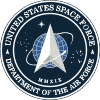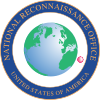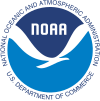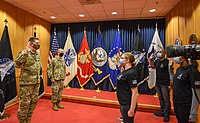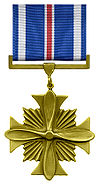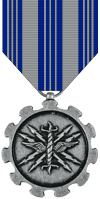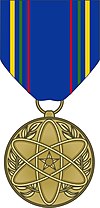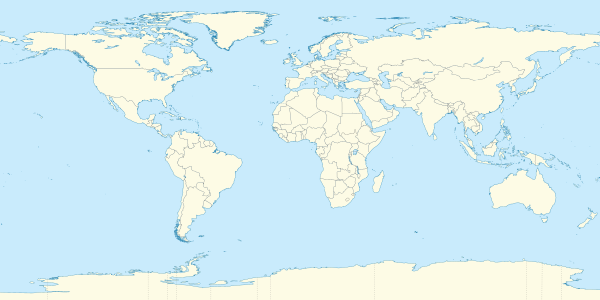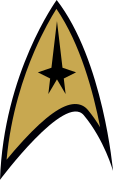United States Space Force
The United States Space Force (USSF) is the space service branch of the United States Armed Forces. Along with the Air Force, it is part of the Department of the Air Force, led by the secretary of the Air Force.[8] Its military heads are the chief of space operations, who is one of the Joint Chiefs of Staff, and the vice chief of space operations.
The Space Force is the smallest U.S. armed service, consisting of 8,600 military personnel.[1] It operates 77 spacecraft in total across various programs such as GPS, Space Fence, military satellite communications constellations, X-37B spaceplanes, U.S. missile warning system, U.S. space surveillance network, and the Satellite Control Network. Under the Goldwater–Nichols Act, the Space Force is responsible for organizing, training, and equipping space forces, which are then presented to the unified combatant commands, predominantly to United States Space Command, for operational employment.
The U.S. Space Force traces its roots to the beginning of the Cold War, with the first military space programs starting in 1945. In 1954, the Air Force established the Western Development Division, the world's first dedicated space organization, under General Bernard Schriever and unified its space forces under Air Force Space Command in 1982. U.S. space forces have participated in every U.S. conflict since the Vietnam War, most notably in the Persian Gulf War, often referred to as the first "space war".
The first discussion of a U.S. Space Force occurred under President Dwight Eisenhower's administration in 1958 and it was nearly established in 1982 by President Ronald Reagan as part of the Strategic Defense Initiative. The 2001 Space Commission argued for the creation of a Space Corps around 2007–2011, but due to the September 11 attacks and war on terror any plans were put on hold. In 2017, Representatives Jim Cooper and Mike Rogers' proposal for a Space Corps passed the House but failed in the Senate. In 2019, the House and Senate resolved their differences to pass the United States Space Force Act. It was signed into law by President Donald Trump, establishing the U.S. Space Force as the first new independent military service since the Army Air Forces were reorganized as the U.S. Air Force in 1947.[9]
Mission
Secure our Nation's interests in, from, and to space.
— Mission statement of the United States Space Force[10]
The Space Force's statutory responsibilities are outlined in 10 U.S.C. § 9081 and originally introduced in the United States Space Force Act, the Space Force is organized, trained, and equipped to:
- Provide freedom of operation for the United States in, from, and to space;
- Conduct space operations; and
- Protect the interests of the United States in space.
The Department of Defense further defines the specified functions of the Space Force to:[11]
- Provide freedom of operation for the United States in, from, and to space.
- Provide prompt and sustained space operations.
- Protect the interests of the United States in space.
- Deter aggression in, from, and to space.
- Conduct space operations.
The Space Force further breaks down its mission into three core functions, which align directly to its mission statement to "secure our Nation's interests in, from, and to space:"
- Space Superiority (in space)
- Global Mission Operations (from space)
- Assured Space Access (to space)
Space Superiority

Space superiority defends against space and counterspace threats by protecting spacecraft in space or protecting against attacks enabled by adversary spacecraft, requiring that the Space Force establish control of the domain. The Space Force describes that at a time and place of the United States' choosing it must be able to assure continued use of spacecraft and deny adversaries use of their spacecraft or space-enabled capabilities.[12]
Mission that support space superiority include orbital warfare, electromagnetic warfare, and space battle management.[13]
Global Mission Operations

Global mission operations integrates joint functions across all domains (land, air, maritime, space, cyberspace) on a global space. Through space, the U.S. military and its allies can see, communication, and navigate. Global mission operations also protect U.S. forces on Earth through early warning of incoming missiles and other types of attack. The Space Force describes global mission operations as allowing the rest of the U.S. military to defend the air, land, and sea.[14]
Missions that support global mission operations include missile warning, satellite communications, and positioning, navigation, and timing.[15]
Assured Space Access

Assured space access ensures that the Space Force can deploy and sustain equipment in outer space. This includes space launches as well as controlling and steering spacecraft out of the way of oncoming space debris to avoid collisions. The Space Force describes assured access to space as being able to make sure it can continue launching and conducting space operations 24/7.
Missions supporting space access include launch, range control, cyber, and space domain awareness.[16]
History
The U.S. military in space
In the long haul, our safety as a nation may depend upon achieving "space superiority." Several decades from now, the important battles may not be sea battles or air battles, but space battles, and we should be spending a certain fraction of our national resources to ensure that we do not lag in obtaining space supremacy.

The beginnings of the U.S. Space Force can be traced to the Aftermath of World War II. General Henry H. Arnold, commander of the Army Air Forces, tasked General Bernard Schriever to integrate with the scientific community to identify and develop technologies that could be beneficial for the new U.S. Air Force in the next global conflict.[19] Each identifying the importance of space, the U.S. Army, U.S. Navy, and U.S. Air Force each started their own separate space and rocket programs. The U.S. Air Force created the first military space organization in the world, establishing the Western Development Division in 1954 and placing it under the command of General Schriever.[20] The Army followed a year later, creating the Army Ballistic Missile Agency under the leadership of General John Bruce Medaris and Dr. Wernher von Braun.[21]
The Army led the United States into space, launching the first American spacecraft, Explorer 1, on 31 January 1958.[22] Space exploration continued to be a military responsibility until the National Aeronautics and Space Administration was created in 1958.[23] The military shifted from conducting their own space exploration programs to supporting NASA's, providing the agency with its astronauts and space launch vehicles, while also conducting astronaut recovery and supporting space launches from the Air Force's Eastern Range.[23]
The Air Force was recognized as the lead military service for space by the early 1960s, with the Army and Navy operating in supporting roles. Early military space efforts were focused on developing and fielding spacecraft to accomplish national objectives, with a focus on weather, reconnaissance and surveillance, communications, and navigation. On 18 August 1961, the Air Force and National Reconnaissance Office launched the first CORONA reconnaissance mission, recovering 3,000 feet of film from space and imagine 1.65 million square miles of the Soviet Union's territory.[24]

Concerned about the development of the Soviet Union's own space forces, the Air Force advocated for a military human spaceflight program. General Curtis LeMay described strong parallels between World War I aviation and 1960s space operations, noting how quickly flying evolved from chivalric and unarmed reconnaissance flights to combat efforts designed to destroy enemy air superiority. General LeMay believed that it was naive to believe that the same trends were not expected to be seen in space and must be prepared for. Although the Air Force made significant progress in developing the X-20 spaceplane, Manned Orbiting Laboratory, and Blue Gemini, opposition from the Department of Defense prevented operational fielding. The Air Force was also forced to cancel Project SAINT, a satellite inspector with satellite neutralization capabilities, when details were leaked to The New York Times in 1962. Despite these setbacks, the Air Force did successfully field the Program 437 anti-satellite weapon system, which used nuclear Thor missiles to intercept enemy spacecraft.[23]
Although most military space forces were organized under the Air Force, they were still fragmented within several different major commands. Recognizing rapid growth of space forces and the need to centralize them under one command, the Air Force established Air Force Space Command in 1982.[25] This was followed by the establishment of the joint United States Space Command in 1985, aligning Air Force Space Command, Naval Space Command, and Army Space Command under a single operational commander. These two moves, along with the Strategic Defense Initiative's establishment by President Ronald Reagan, led to a renaissance of military space operations in the 1980s.[23]
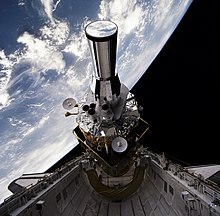
Space forces were first used in combat operations during the Vietnam War, with Air Force weather and communications spacecraft supporting ground, sea, and air operations.[23] During Operation Urgent Fury in Grenada, satellite communications were used to conduct command and control for the first time, while Operation El Dorado Canyon and Operation Just Cause marked the first time that major U.S. forces incorporated information from space-based intelligence systems.[26]
The Persian Gulf War marked the first time that military space forces were unleashed to their fullest extent. Over sixty spacecraft provided 90% of theater communications and command and control for a multinational army of 500,000 troops, weather support for commanders and mission planners, missile warning of Iraqi Scud missile launches, and satellite navigation for air and land forces moving across a featureless desert.[23][27] The decisive role that space forces played directly enabled an overwhelming Coalition victory and led to the Persian Gulf War being coined "the first Space War."[28]
While U.S. space forces supported all U.S. military operations in the 1990s, Operation Allied Force marked the first use of Global Positioning System-aided munitions in a conflict, ushering in a new era of precision bombing.[29] Following the September 11 attacks, U.S. space forces mobilized to respond as part of the Global War on Terroism Operation Enduring Freedom, Operation Iraqi Freedom, and Operation Inherent Resolve.[30]
Path to a separate space service
Creating a new military service...would be a dramatic step. Perhaps a "Space Corps" would be a step toward a Space Force. Maybe the Air Force will preempt these dramatic changes by truly becoming the "Space and Air Force."

The idea of a separate service for space originated in the 1960s. Military space activities were briefly consolidated under the Advanced Research Projects Agency in 1958, loosely centralizing space activities under a single organization. The Air Force, Army, and Navy feared that it would evolve into a "fourth service" for space, before authorities were returned to the service.[23]
The first direct call for a U.S. Space Force occurred in 1982, prior to Air Force Space Command's establishment or the Strategic Defense Initiative's public announcement. As part of a report recommending the acceleration U.S. space-based laser weapon development, the Government Accountability Office recommended the U.S. Air Force be reorganized as the U.S. Aerospace Force or that an independent U.S. Space Force be created.[32] Ultimately, a Congressional proposal to rename the U.S. Air Force as the U.S. Aerospace Force and speculation that President Ronald Reagan may announce the creation of a U.S. Space Force accelerated Air Force plans to create a space command within the service.[23]
Following the Persian Gulf War, the Air Force and Defense Department declared that "space power has now become as important to the nation as land, sea, and air power." Despite this public pronouncement, a growing section of Congress believed that space was being shortchanged and used only as an auxiliary to air operations. In 1998, drawing parallels between the challenges faced by post-World War I Army Aviators and post-Gulf War Air Force space operators, Senator Bob Smith publicly called for the establishment of a Space Force if the Air Force could not, or would not, embrace spacepower. An independent Department of the Space Force would ensure that space got its fair share of resources within the Defense Department, with Senator Smith calling for the creation of a Space Corps within the Department of the Air Force as a bridge to a fully independent Space Force. [33]
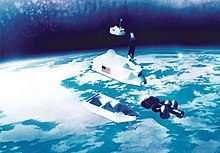
In 2000, Senator Smith led Congress in establishing a commission to examine the organization and management of national security space. The Commission to Assess United States National Security Space Management and Organization, better known as the 2001 Space Commission or the Rumsfeld Commission, released its report in 2001. The Rumsfeld Commission noted the strong risk of a "Space Pearl Harbor," harking back to Imperial Japan's surprise attack on the U.S. Pacific Fleet in 1941. It was extremely critical of the Air Force's treatment of space, with few witnesses expressing confidence that the Air Force would address the requirement to provide space capabilities to the other services or move beyond treating space as just a support capability for air operations. The most significant recommendation of the Rumsfeld Commission was the creation of a Space Corps within the Department of the Air Force in the mid-term, which would evolve into a Department of the Space Force in the long-term. The Rumsfeld Commission expected the transition from Air Force Space Command to a fully independent Space Force to occur in between 2006 and 20011. [34][35]
Air Force leadership reacted extremely poorly to the Rumsfeld Commission's recommendations. The day after the Commission was publicly released Air Force Chief of Staff General Michael E. Ryan declared "an independent Space Force or Corps was not warranted for at least another 50 years." General Ryan doubled down over the following year, stating that a Space Force should only be considered once space operations moved beyond Earth orbit. Despite the Air Force's hostility to the idea of a Space Corps or Space Force, they did meet some recommendations by transferring the Space and Missile Systems Center from Air Force Materiel Command to Air Force Space Command and establishing the National Security Space Institute.[36] Ultimately, the Rumsfeld Commission's recommendations remained unfulfilled because of the higher priority placed on counterterrorism after the September 11 attacks, canceling plans for a Space Corps within the Department of the Air Force or a fully independent Space Force by 2011.[37]

While the United States' focus shifted from space to counterterrorism, the Russian Armed Forces and Chinese People's Liberation Army realized the military benefits that could be gleaned from space, as well as the incredible reliance the United States put on its space forces. Throughout the 2000s, Russian and Chinese space and counterspace capabilities began to increase. [38] In 2001, the Russian Space Forces were reestablished as an independent arm and in 2007, China conducted a destructive anti-satellite missile test causing the single largest space debris generating event in history.[39][40][41] In the aftermath of the Chinese ASAT test, Congress tasked the Allard Commission to reevaluate the Defense Department's space organization and management. The Allard Commission noted that the United States' dependance on space had increased, but comparatively little...[had] been achieved to make them more secure." It also noted, despite the recommendations of the Rumsfeld Commission, authority and responsibility for national security space remained fragmented and unfocused. Like the 2001 Rumsfeld Commission, the 2008 Allard Commission recommended establishing a Space Corps within the Department of the Air Force or a separate Department of the Space Force to unify national security space. [42]
It took until 2017 for members of Congress to act on the recommendations of the Rumsfeld and Allard commissions to create a Space Corps within the Department of the Air Force. Representatives Mike Rogers and Jim Cooper unveiled a bipartisan proposal to establish a Space Corps within the Department of the Air Force, however it experienced significant opposition from the Air Force and Defense Department, failing in the Senate. [43][44] However, the proposal was resurrected in 2018 when President Donald Trump publicly endorsed the creation of a Space Force and directed the Defense Department to reverse its opposition and develop plans for its establishment.[45][46] The Trump Administration plan for the U.S. Space Force was outlined in Space Policy Directive-4, initially organizing the U.S. Space Force as part of the Department of the Air Force, but with plans to build out a separate Department of the Space Force in the future.[47] In 2019, Congress passed legislation establishing the U.S. Space Force as a military service under the Department of the Air Force. On 20 December 2019, the National Defense Authorization Act was signed into law and the U.S. Space Force was established as the sixth armed service, meeting the Rumsfeld and Allard commissions' recommendations to create a Space Corps within the Department of the Air Force, but still falling short of creating a separate Department of the Space Force.[48]
The sixth service
We are at the dawn of a new era for our Nation’s Armed Forces. The establishment of the U.S. Space Force is an historic event and a strategic imperative for our Nation. Space has become so important to our way of life, our economy and our national security that we must be prepared as a Nation to protect it from hostile actions.
— Secretary of Defense Mark Esper, 20 December 2019[49]
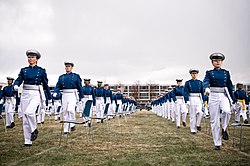
As the U.S. Space Force was established on 20 December 2019, General Jay Raymond, commander of U.S. Space Command and Air Force Space Command, became its first member and chief of space operations. Air Force Space Command was immediately redesignated as United States Space Force, however, the command and its 16,000 Airmen technically remained part of the Air Force.[50] On 3 April 2020, Chief Master Sergeant Roger A. Towberman became the Space Force's second member and was appointed its first senior enlisted leader.[51] The service gained its first new second lieutenants when 86 members of the U.S. Air Force Academy class of 2020 became Space Force members 3 through 88 on 18 April 2020.[52] Currently serving Air Force space operators began to become Space Force members in September 2020 and the service gained its first astronaut when Colonel Michael S. Hopkins swore into the Space Force aboard the International Space Station on 18 December 2020.[53][54][55][56]
The Space Force also began to build out its culture and identity, however, it experienced several public relations challenges due to its perceived ties to science fiction and links to President Trump.[57] The Space Force adopted the Army and Air Force's OCP Uniform with blue stitching and a full color U.S. flag, sparking jokes about fighting on the forest moon of Endor from Star Wars: Return of the Jedi, while its distinctive service dress drew comparisons to Colonial Fleet uniforms from Battlestar Galactica or Starfleet uniforms from Star Trek. While the Space Force noted that its camouflage combat uniform was appropriate since space operators deploy to combat zones on the Earth alongside the rest of the joint force and it saved money, it did not have a similar response for its service dress uniform, which were described as a "futuristic-looking" design by General Raymond.[58][59][60][61] The Space Force's seal and delta insignia were also incorrectly derided as a rip-off of Star Trek's Starfleet logo, despite being first adopted as a space symbol by the Air Force Ballistic Missile Division in 1962, four years before Star Trek first aired on television in 1966.[62] Star Trek actor William Shatner settled the issue, recalling that Starfleet's logo was chosen as an homage to the Space Force's direct predecessors in military space operations.[62]
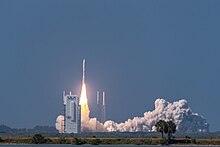
The service also chose the title "Guardian" to represent its personnel, becoming its counterpart to Soldier and Airman. The term "Guardian" has a long history within Air Force Space Command, originally serving as part of it's motto: "Guardians of the High Frontier."[63] The Space Force also adopted Semper Supra as its official motto and unveiled its service song, sharing the same name.[64] The decision on if the Space Force's ranks would mirror the Army, like the Air Force and Marine Corps, or the Navy, generated significant controversy, with Congressman Dan Crenshaw introducing an amendment which would force the Space Force to pattern itself after the Navy's rank structure.[65] Ultimately, the amendment failed and the Space Force followed an Air Force/Army/Marine Corps-based rank scheme.[66]
The Space Force began to officially incorporate former Air Force Space Command units in 2020 and 2021, standing up field commands to serve as counterparts to the Air Force's major commands. It also consolidated Air Force wings and groups into mission deltas, a formation roughly equivalent to an Army Brigade Combat Team or Air Force expeditionary wing, and space base deltas (briefly known as garrisons), equivalent to an Army garrison or Air Force air base wing.[67][68] It also began to rename former Air Force bases and station to Space Force bases and station, starting with Patrick Space Force Base and Cape Canaveral Space Force Station.[69] It also established component field commands to serve as Space Force components at the unified combatant commands, assuming space component responsibility from the U.S. Air Force.[70]

One of the primary reasons the Space Force was created was to consolidate space forces from across the U.S. Air Force, U.S. Army, and U.S. Navy.[71] In 2020, the Space Training and Readiness Delta (Provisional) was established to form the foundation for Space Training and Readiness Command and incorporate Air Force space units spread across Air Combat Command and Air Education and Training Command, while Space Systems Command incorporated space acquisitions activities across Air Force Materiel Command, although, notably it did not incorporate space research and development conducted by the Air Force Research Laboratory.[72][73] The Space Force also began incorporating space personnel transfers from the U.S. Army, U.S. Navy, and U.S. Marine Corps.[74] In 2022, it the Naval Satellite Operations Center and Army's Satellite Operations Brigade transferred to the Space Force, putting satellite communications under a single service for the first time in history.[75][76] In 2023, it assumed responsibility for the Army's Joint Tactical Ground Station, putting all space-based missile warning under the Space Force.[77]
The Space Force's first significant combat action occurred less than a month after its establishment, providing missile warning when Iran launched missile strikes against U.S. troops at Al Asad Airbase on 7 January 2020.[78] In 2021, the Russian Federation conducted an anti-satellite weapons test, destroying the Kosmos 1408 and putting the International Space Station at risk.[79]
Organization

The Space Force's field organizations consist of three different echelons of command:[80]
- Field commands (FLDCOM): Align with a specific mission focus and are typically led by a lieutenant general or major general, although smaller component field commands and Space Force elements may have officers ranging from lieutenant colonel to major general in command. Component field commands are the Space Force component to a unified combatant command.[81]
- Deltas are organized around a specific function, such as operations, training, or installation support and are typically led by a colonel. In rare cases, a delta may be commanded by a higher-ranking officer, such as a major general in the case of Space Launch Delta 45. Deltas are equivalent to an Air Force wing or an Army brigade combat team.
- Squadrons are focused on specific tactics and are led by a lieutenant colonel.
Each of the three major field commands has a distinctive color which is shared by its subordinate units. Space Operations Command is platinum, Space Systems Command is gold, and Space Training and Readiness Command is Cannes Blue.
Headquarters Space Force

The U.S. Space Force is organized under the Department of the Air Force, alongside the U.S. Air Force. Civilian leadership is provided by the Secretary of the Air Force and under secretary of the Air Force. The most important assistant secretary of the Air Force for the Space Force is the Assistant Secretary of the Air Force for Space Acquisition and Integration, who is the only assistant secretary of the Air Force focused entirely on space and serves as the Space Force's service acquisition executive.[82]
Military leadership is provided by the chief of space operations and vice chief of space operations, who are advised by the chief master sergeant of the Space Force.[83][84] Headquarters Space Force, also known as the Office of the Chief of Space Operations or Space Staff, serves as the service's highest staff and headquarters element, is located at the Pentagon. It is led by the chief of space operations and the vice chief of space operations.[85][86]
Field commands, Space Force elements, and direct reporting units
Deltas and program executive offices
Relationships with other space organizations
Department of the Air Force and U.S. Air Force
The U.S. Space Force derives a significant degree of support from the Department of the Air Force and the U.S. Air Force. The Space Force proper consists only of operators and acquisitions, relying on the Air Force to provide airmen in support or other niche specialties. Air Force Materiel Command provides major command support to airmen assigned to the Space Force. The Space Force and Air Force continue to share a number of different organizations, such as the United States Air Force Academy and Air Force Research Laboratory.[92]

Following the United States Space Force's establishment, calls have been made for the Department of the Air Force to rename itself the Department of the Air and Space Forces to acknowledge the Space Force, similar to calls made for the Department of the Navy to rename itself the Department of the Navy and Marine Corps. SpaceNews reported that a proposed name change was considered in 2018 and in 2019 the Air Force Association also called for renaming the department.[93][94] In 2022, the Air Force Association renamed itself the Air & Space Forces Association, internally acting on its proposal to reflect the Space Force in the organization's name.[95] In a 2021 article in the Space Force Journal, two Space Force officers also proposed a name change for the department.[96]
National Aeronautics and Space Administration
The U.S. Space Force and its antecedents have a long history of cooperation with NASA, as the lead government agencies for military and civil spaceflight. The Space Force's predecessors in the Air Force, Navy, and Army provided NASA with its early space launch vehicles and most of its astronauts.[97]
The Space Force hosts NASA launch operations at Vandenberg Space Force Base and Cape Canaveral Space Force Station.[98][99] NASA occasionally hosts U.S. Space Force heavy launches out of Kennedy Space Center.[100] The Space Force continues to support NASA's human spaceflight missions with range support of Space Launch Delta 45 and tracks threats to the International Space Station and other crewed spacecraft.[101][102]
The Space Force and NASA partner on matters such as space domain awareness and planetary defense.[103] Space Force members can be NASA astronauts, with Colonel Michael S. Hopkins, the commander of SpaceX Crew-1, commissioned into the Space Force from the International Space Station on 18 December 2020.[54][55][56]
National Reconnaissance Office
The National Reconnaissance Office (NRO) is a Department of Defense agency and a member of the United States Intelligence Community, responsible for designing, building, launching, and maintaining intelligence satellites.[104] The Space Force executes National Reconnaissance Office space launches and consists of 40% of the agency's personnel.[105][106][107] Proposals have been put forward, including by the Air Force Association and retired Air Force Lieutenant General David Deptula, to merge the NRO into the Space Force, transforming it into a Space Force Intelligence, Reconnaissance, and Surveillance Command and consolidating the entire national security space apparatus in the Space Force.[108][109][110]

The USSF's Space Systems Command (SSC), in partnership with the National Reconnaissance Office, manages the National Security Space Launch (NSSL) program, which uses government and contract spacecraft to launch sensitive government payloads.[111][112] NSSL supports both the USSF and NRO.[112] NRO director Scolese has characterized his agency as critical to American space dominance and the Space Force, stating that NRO provides "unrivaled situational awareness and intelligence to the best imagery and signals data on the planet."[111] Additionally, in August 2021, former NRO deputy director Lt Gen Michael Guetlein became commander of Space Systems Command.[113]
National Oceanic and Atmospheric Administration
The Space Force and the National Oceanic and Atmospheric Administration (NOAA) jointly operate the military's weather satellites.[114] Additionally, NOAA's Office of Space Commerce is responsible for civilian space situational awareness and space traffic management.[115]
The decision to transition space traffic management from the military to the Department of Commerce was made due to the significant growth in commercial spacecraft and to mirror how the Federal Aviation Administration, rather than the U.S. Air Force, handles air traffic management.[116]
Personnel and culture
Symbols
The Delta Symbol
In the late 19th and early 20th centuries, scientists derived the rocket equation, which made spaceflight possible. In this equation, represents the change in velocity. Since the 20th century, the Delta has been used to represent a stylized aircraft, missile, or arrow. In 1940, the United States Army Air Forces 36th Fighter Group used the delta on its shield, which is still used by the U.S. Air Force 36th Fighter Wing.[117]
After World War II, the delta began to be used by the space program, appearing on the joint U.S. Air Force-NASA X-15. In 1962, the Air Force Ballistic Missile Division became the first of a long line of international military space organizations to use the delta, which, in the Air Force Space Command shield represented the Air Force's upward thrust into space and the launch vehicles used to place satellites into orbit. This delta later evolved into the U.S. Space Force's seal and its logo in 2020, becoming the basic shape for field command and delta emblems.[117]
Guardians

Space Force service members have the title of Guardians, similar to how members of the U.S. Marine Corps are called Marines and members of the Air Force are called Airmen. The title of guardian traces its heritage to Air Force Space Command's 1983 motto Guardians of the High Frontier.[118] Prior to the announcement of Guardian as the service title on 18 December 2020, members of the Space Force were referred to as space professionals.[119]
Semper Supra
The Space Force's motto, Semper Supra – "Always Above".[120] It mirrors the mottos of the Marine Corps (Semper Fidelis – Always Faithful) and Coast Guard (Semper Paratus – Always Ready).[121][122] The Space Force's service song takes its name from the motto.[123]
Specialties and badges
 Space Operations |
 Intelligence |
 Cyberspace Operations |
 Acquisition and engineering |
|---|---|---|---|
| Officer | |||
|
|
|
|
| Enlisted | |||
|
|
| |
Space operators are the largest career field in the Space Force and comprise much of its senior leadership.[124] Space operations officers are responsible for leading the Space Force's space operations forces. Space operations officers (13S) are responsible for planning and leading space combat operations across orbital warfare, space electromagnetic warfare, space battle management, and space access and sustainment spacepower disciplines. They also formulate space operations policy, coordinate space operations, and plan, organize, and direct space operations programs.[125][126] Enlisted Space Systems Operators (5S) are responsible for conducting orbital warfare, space electromagnetic warfare, space battle management, and space access and sustainment operations.[127][128] Space operations officers and enlisted space systems operators are awarded the Space Operations Badge after completing the 533rd Training Squadron's Undergraduate Space Training program at Vandenberg Space Force Base, with follow-on education provided by the 319th Combat Training Squadron and National Security Space Institute.[129]

The Space Force currently has two astronauts (13A) who flew as Space Force officers on assignment to NASA. Space Force astronauts command, operate, and pilot crewed spacecraft, accomplish on-orbit duties on the International Space Station or other spacecraft, operate Department of Defense payloads, and provide spaceflight consultation to the Department of Defense and other government agencies. Space Force astronauts must complete NASA Astronaut Candidate (ASCAN) training at Johnson Space Center. Once completing a spaceflight, Space Force astronauts are awarded the observer badge with astronaut rating.[126]
Intelligence officers (14N) lead the Space Force's intelligence, surveillance, and reconnaissance enterprise, performing intelligence activities and analysis.[130] They lead enlisted All Source Intelligence Analysts (5I0), Geospatial Intelligence Analysts (5I1), Signals Intelligence Analysts (5I2), and Fusion Analysts (5I4), and Targeting Analysts (5I8).[131][132][133][134][135][128] Intelligence officers and enlisted analysts are awarded their intelligence badge after completing intelligence training with the 533rd Training Squadron Detachment 1 at Goodfellow Air Force Base, with follow-on education provided by the 319th Combat Training Squadron and National Security Space Institute.[136]

Cyberspace effects operations officers (17S) are responsible for operating cyberspace weapons systems, satellite communications systems, and commanding cyber crews.[126] They lead enlisted Cyberspace Operations guardians.[137] Cyberspace effects operations officers and enlisted cyberspace operators are awarded the cyberspace operator badge after completing Undergraduate Cyber Training with the Air Force's 81st Training Wing at Keesler Air Force Base, with follow-on education provided by the 319th Combat Training Squadron and National Security Space Institute.[138]
Acquisition and engineering are officer only career fields within the Space Force. Specific developmental engineers (62E) include aeronautical engineers (62EXA), astronautical engineers (62EXB), computer systems engineers (62EXC), electrical/electronic engineer (62EXE), mechanical engineer (62EXH) and the human factors engineer/human systems integration (62EXI). Space Force engineers graduate from the Defense Acquisition University and the U.S. Air Force Flight Test Engineer course, or a comparable program.[139][140][141][142][143][144] Acquisition managers (63A) are responsible for the Space Force's acquisition process.[145]
Spacepower disciplines
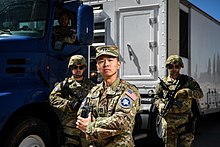
The U.S. Space Force has seven core spacepower disciplines which its personnel gain experience in:[146]
- Orbital Warfare: Knowledge of orbital maneuver as well as offensive and defensive fires to preserve freedom of access to the domain. Skill to ensure United States and coalition space forces can continue to provide capability to the Joint Force while denying that same advantage to the adversary.
- Space Electromagnetic Warfare: Knowledge of spectrum awareness, maneuver within the spectrum, and non-kinetic fires within the spectrum to deny adversary use of vital links. Skill to manipulate physical access to communication pathways and awareness of how those pathways contribute to enemy advantage.
- Space Battle Management: Knowledge of how to orient to the space domain and skill in making decisions to preserve mission, deny adversary access, and ultimately ensure mission accomplishment. Ability to identify hostile actions and entities, conduct combat identification, target, and direct action in response to an evolving threat environment.
- Space Access and Sustainment: Knowledge of processes, support, and logistics required to maintain and prolong operations in the space domain. Ability to resource, apply, and leverage spacepower in, from, and to the space domain.
- Military Intelligence: Knowledge to conduct intelligence-led, threat-focused operations based on the insights. Ability to leverage the broader Intelligence Community to ensure military spacepower has the intelligence, surveillance, and reconnaissance capabilities needed to defend the space domain.
- Engineering and Acquisition: Knowledge that ensures military spacepower has the best capabilities in the world to defend the space domain. Ability to form science, technology, and acquisition partnerships with other national security space organizations, commercial entities, Allies, and academia to ensure the warfighters are properly equipped.
- Cyber Operations: Knowledge to defend the global networks upon which military spacepower is vitally dependent. Ability to employ cyber security and cyber defense of critical space networks and systems. Skill to employ future offensive capabilities.
Rank structure
Officers


Officers are the leaders of the U.S. Space Force and are responsible for planning operations and managing personnel. Space Force officers enter the service through three different paths: graduating from the United States Air Force Academy, Air Force Reserve Officer Training Corps, or Air Force Officer Training School.[147]
The premier commissioning route for Space Force officers is through the U.S. Air Force Academy, a public university and military academy. Approximately ~10% of each class commissions as U.S. Space Force officers, with the remainder entering into the U.S. Air Force.[148] Space Delta 13, Detachment 1 is responsible for providing Space Force training, immersion, and mentorship to cadets. The Air Force Academy has a long history with Air Force space, establishing the world's first Department of Astronautics in 1958 and the Cadet Space Operations Squadron, which operates the FalconSAT satellites, in 1997.[149][150][151][152] Additional space programs, such as the Azimuth program, i5 Squadron and Blue Horizon rocketry club have stood up and as of 2023, the Air Force Academy offers two space majors, a space warfighting minor, and 29 space courses across all its academic departments.[153] On 18 April 2020, the Air Force Academy commissioned 86 officers into the Space Force, becoming the first group of individuals to enter the service after the first chief of space operations, General Jay Raymond, and the senior enlisted advisor of the Space Force, Chief Master Sergeant Roger Towberman.[154]
The Air Force Reserve Officer Training Corps program is offered at 1,100 colleges and universities. Like the Air Force Academy, it commissions officers directly into either the Air Force or Space Force.[155] The Air Force Officer Training School is the final path to commission into the Space Force, graduating its first two Space Force officers on 16 October 2020 and its first all-Space Force flight graduating on 17 March 2023.[156][157]
The Space Force partners with Johns Hopkins University's Paul H. Nitze School of Advanced International Studies to provide Intermediate Developmental Education and Senior Developmental Education.[158] Additional educational opportunities for officers include the 319th Combat Training Squadron, National Security Space Institute, Air Force Institute of Technology, U.S. Air Force Weapons School, the Acquisition Instructor Course, U.S. Air Force Test Pilot School, the Space Test Course, and Air University's School of Advanced Air and Space Studies.[159][160][161][162][163]
| US DoD pay grade |
O-10 | O-9 | O-8 | O-7 | O-6 | O-5 | O-4 | O-3 | O-2 | O-1 | Officer candidate |
|---|---|---|---|---|---|---|---|---|---|---|---|
| NATO code | OF-9 | OF-8 | OF-7 | OF-6 | OF-5 | OF-4 | OF-3 | OF-2 | OF-1 | OF(D) | |
| Insignia | Various insignia | ||||||||||
| Service dress uniform (Class A) | 
|

|

|

|

|

|

|

|

|

|

|
| Title | General | Lieutenant general | Major general | Brigadier general | Colonel | Lieutenant colonel | Major | Captain | First lieutenant | Second lieutenant | Cadet / Officer trainee |
| Abbreviation | Gen | Lt Gen | Maj Gen | Brig Gen | Col | Lt Col | Maj | Capt | 1st Lt | 2d Lt | Cdt / OT |
Enlisted

Enlisted members participate in and support operations. Space Force enlisted members complete Basic Military Training at Joint Base San Antonio. Space Force Basic Military Training is identical to Air Force Basic Military Training, with the addition of Space Force-specific curriculum.[164] On 20 October 2020, the first four individuals enlisted into the Space Force and on 10 December 2020, the first seven enlisted members to enter the Space Force graduated from Basic Military Training.[165][166] In May 2022, the Space Force started running its own all-Guardian Basic Military Training to reinforce Space Force culture.[167]
Space Force enlisted members are enrolled in the Community College of the Air Force, earning an associate in applied science degree.[168] Professional military education is conducted at Space Training and Readiness Command's Forrest L. Vosler Non-Commissioned Officer Academy.[169] Other educational opportunities for enlisted members include the 319th Combat Training Squadron, National Security Space Institute, Advanced Instructor Course and the Space Test Course.[170][163]

The Space Force's enlisted rank design is centered on a hexagon, representing the Space Force's status as the sixth military service in the Armed Forces. The horizontal stripes for Specialist 2, 3, and 4 were inspired by an early proposal for Air Force enlisted ranks known as "Vandenberg stripes". The delta represents the Space Force. The specialist stripes represent terra firma, the solid foundation of skills upon which the Space Force is built. Noncommissioned officer insignia feature traditional chevrons and the "Delta, Globe, and Orbit," representing the totality of the Space Force. Finally, senior noncommissioned officer insignia are topped with "orbital chevrons", representing low Earth orbit for master sergeants, medium Earth orbit for senior master sergeants, and geosynchronous orbit for chief master sergeants. These orbital chevrons signify the higher levels of responsibility and willingness to explore and innovate placed upon senior noncommissioned officers. Finally, the Chief Master Sergeant of the Space Force is represented by a "Delta, Globe, and Orbit" in a hexagonal wreath.[171]
-
Vice Chief of Space Operations General David D. Thompson swears in the first four enlisted Space Force recruits on 20 October 2020
-
The first seven enlisted guardians graduate from Basic Military Training on 10 December 2020
| US DoD pay grade | Special | E-9 | E-8 | E-7 | E-6 | E-5 | E-4 | E-3 | E-2 | E-1 | |
|---|---|---|---|---|---|---|---|---|---|---|---|
| NATO code | OR-9 | OR-8 | OR-7 | OR-6 | OR-5 | OR-4 | OR-3 | OR-2 | OR-1 | ||
| Insignia | 
|

|

|

|

|

|

|

|

|

|

|
| Title | Senior Enlisted Advisor to the Chairman | Chief Master Sergeant of the Space Force | Chief master sergeant | Senior master sergeant | Master sergeant | Technical sergeant | Sergeant | Specialist 4 | Specialist 3 | Specialist 2 | Specialist 1 |
| Abbreviation | SEAC | CMSSF | CMSgt | SMSgt | MSgt | TSgt | Sgt | Spc4 | Spc3 | Spc2 | Spc1 |
Uniforms
| Air Force Mess Dress Uniform (interim) | Service Dress Uniform Class "A" |
Service Uniform Class "B" |
Air Force Service Dress Uniform (interim) | OCP Uniform | Physical Training Uniform | |
|---|---|---|---|---|---|---|
 |
 |
 |
 |
 |
 |
 |

The Space Force is currently in the process of developing its unique mess dress, service dress, and physical training uniforms.[172] In the interim period, guardians wear the Air Force Mess Dress, Air Force Service Dress, and Air Force Service uniforms with the following modifications:[173]
- Space Force insignia on the coat/shirt
- Replaced "Hap Arnold Star & Wings" buttons with "Delta, Globe, & Orbit" buttons
- Replaced Air Force Great Seal of the United States service cap badges with Space Force Delta, Globe, and Orbit service cap badges
- Replaced Air Force nametag with Space Force hexagonal nametag
- Space Force enlisted rank worn in place of Air Force enlisted ranks (enlisted only)
- Replaced Circle U.S. lapel insignia with Hexagonal U.S. insignia (enlisted only)
The primary Space Force uniform is the OCP Uniform, adopted from the U.S. Air Force and the U.S. Army. The Space Force uses unique "space blue" thread for ranks and badges, wears a full color flag on the left sleeve, and wears full color patches.[174]

The Space Force's distinctive blue and gray service dress uniform was unveiled at the Air & Space Forces Association's 2021 Air, Space, and Cyber conference. The dark blue was taken from the Space Force's seal and represents the vastness of outer space, while the six buttons represent that the U.S. Space Force is the sixth armed service.[175] The Space Force's Physical Training Uniform was unveiled in September 2021. As of April 2023, the Space Force stated that the Physical Training Uniform would be available by early 2024 and that the Service Dress Uniform would be available by late 2025.[176]
Space Force cadets at the Air Force Academy wear the same uniform as Air Force cadets; however, in their distinctive blue and white parade dress uniforms they wear a platinum sash in place of the gold sash worn by Air Force cadets.[177]
Awards and decorations
As part of the United States Department of the Air Force, the United States Space Force and United States Air Force share the same awards and decorations or same variations of awards and decorations.[178]
On 16 November 2020, the Secretary of the Air Force Frank Kendall III renamed the Air Force Commendation Medal, the Air Force Achievement Medal, Air Force Outstanding Unit Award, Air Force Organizational Excellence Award, Air Force Recognition Ribbon, Air Force Overseas Ribbons, Air Force Expeditionary Service Ribbon, Air Force Longevity Service Award, and the Air Force Training Ribbon to replace "Air Force" with "Air and Space" to include the Space Force. He also eliminated Air Force from the Air Force Combat Action Medal and renamed the Air Force Special Duty Ribbon to the Developmental Special Duty Ribbon.[179]
The Space Force is currently in the process of developing a Space Force Good Conduct Medal to replace the Air Force Good Conduct Medal for enlisted members which was approved on 30 August 2023.[180][181] Congress has also debated changing the Airman's Medal, awarded for non-combat heroism, to the Air and Space Force Medal, mirroring the Navy and Marine Corps Medal.[182]
| Arctic "A" Device | Arrowhead Device | Combat "C" Device | Oak leaf cluster | Remote "R" Device | Service Star | Valor "V" Device | ||
|---|---|---|---|---|---|---|---|---|
Decorations
Unit awards
| Presidential Unit Citation | Gallant Unit Citation | Meritorious Unit Award | Air and Space Outstanding Unit Award | Air and Space Organizational Excellence Award |
|---|---|---|---|---|
Campaign, expeditionary, and service awards
Locations
Continental United States
Installations and locations in the contiguous United States.
Overseas
| Name | Location | Space Base Delta or primary unit emblem | Space Base Delta or primary unit | Major units |
|---|---|---|---|---|
| Clear Space Force Station |  |
13th Space Warning Squadron | ||
| Kaena Point Space Force Station |  |
21st Space Operations Squadron (Detachment 3) | ||
| Maui Space Surveillance Complex |  |
15th Space Surveillance Squadron[183] | ||
| Pituffik Space Base |  |
821st Space Base Group | 12th Space Warning Squadron |
Spacecraft and space systems
Spacecraft
Space systems
Space launch vehicles
| Name | Space launch vehicle image | Class | Contractor |
|---|---|---|---|
| Atlas V |  |
Medium-lift launch vehicle | United Launch Alliance |
| Electron |  |
Small-lift launch vehicle | Rocket Lab |
| Falcon 9 |  |
Medium to Heavy-lift launch vehicle | SpaceX |
| Falcon Heavy |  |
Heavy to Super heavy-lift launch vehicle | SpaceX |
| Pegasus |  |
Air launched small-lift launch vehicle | Northrop Grumman |
Modernization and budget
| United States Space Force Budget | 2020[200] | 2021[201] | 2022[202] | 2023 (Enacted)[203] | 2024 |
|---|---|---|---|---|---|
| Operation & Maintenance | $40,000,000 | $2,492,114,000 | $3,611,012,000 | $4,086,883,000 | TBA |
| Procurement | — | $2,310,994,000 | $2,787,354,000 | $4,462,188,000 | $3,752,194,000 |
| Research, Development, Test & Evaluation | — | $10,540,069,000 | $11,794,566,000 | $16,631,377,000 | $19,551,449,000 |
| Military Personnel | — | — | — | $1,109,400,000 | TBA |
| Total | $40,000,000 | $15,343,177,000 | $18,192,932,000 | $26,289,848,000 | TBA |

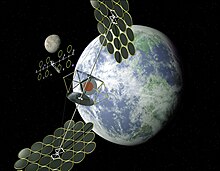
While a new service, the U.S. Space Force is undergoing intensive modernization efforts. The Deep Space Advanced Radar Capability (DARC) is intended to track objects in geosynchronous orbit with three sites, one in the United States, one in the Indo-Pacific, and one in Europe.[204]
Oracle, a spacecraft developed by the Air Force Research Laboratory for the Space Force, will demonstrate technologies that the space service needs for cislunar domain awareness – tracking objects outside of geosynchronous orbit and between Earth and the Moon. The spacecraft itself will launch to an area of gravitational stability between the Earth and the Moon to conduct operations, using a wide-field sensor and a more sensitive narrow field sensor to discover and maintain custody of objects operating in this region. Oracle will directly support NASA's Artemis program as it returns to the Moon and track potentially hazardous near-Earth objects in support of planetary defense operations.[205]
Also an Air Force Research Laboratory program for the Space Force, Arachne is the keystone experiment in the Space Solar Power Incremental Demonstrations and Research Project, which aims to prove and mature essential technologies for a prototype space-based solar power transmission system capable of powering a forward operating base. Arachne will specifically demonstrate and mature technologies related to more efficient energy generation, radio frequency forming, and radio frequency beam beaming. Current forward operation bases rely on significant logistics convoys to transport fuel for power – space-based solar power would move these supply lines to space, where they are unable to be easily attacked. Much how GPS started as a military program and was opened to civilian use, Space Force provided space-based solar power could transition to common use as well.[206] Other space-based power beaming demonstrators include the Space Power InfraRed Regulation and Analysis of Lifetime (SPIRRAL) and Space Power INcremental DepLoyable Experiment (SPINDLE) experiments.[207]

The Navigation Technology Satellite-3 (NTS-3), building on the Space Force's Global Positioning System constellation, is an Air Force Research Laboratory spacecraft that will operate in geosynchronous orbit to test advanced techniques and technologies to detect and mitigate interference to positioning, navigation, and timing capabilities and increase system resiliency for military, civil, and commercial users. NTS-3 is a Vanguard program, which mark potentially game changing technologies.[208]
The Space Force's Rocket Cargo program is another Air Force Research Laboratory Vanguard program, which is focused on leasing space launch services to quickly transport military materiel to ports across the globe. If proven viable, the Space Force's Space Systems Command is responsible for transitioning it to a program of record. United States Transportation Command would be the primary user of this capability, rapidly launching up to 100 tons of cargo anywhere in the world.[209]
Public image and reception
Despite the increasing military threats in space and the reorganization of the Russian Space Forces and the People's Liberation Army Strategic Support Force, the U.S. Space Force has had significant challenges with its public image.[210][211]
One major challenge was perceived ties to former President Donald Trump who in 2018 supported the proposal, falsely claiming "nobody even thought about the Space Force" before him. The Space Force was accused of being a "vanity project" for President Trump, despite the concept being debated since the 1990s as a means to counter Chinese and Russian military threats in space and most recently being proposed by representatives Jim Cooper and Mike Rogers in 2017.[212] The idea of the Space Force was popular with supporters of former President Donald Trump, and his presidential campaign sold unofficial Space Force merchandise – a practice he has been criticized for.[213] The creation of the Space Force, signed into law by Trump, resulted in some jokes, memes, and controversies online.[213][214] Late night talk show hosts such as Jimmy Kimmel and Stephen Colbert joked about the idea and a Netflix comedy show, Space Force, has a plot involving the establishment of a United States Space Force – finding humor in Trump's involvement, but also addressing the threats that the real Space Force exists to deal with.[215][216] Following the end of the Trump administration and the Biden administration's announcement that they were not reevaluating its establishment, less critical and more analytical coverage of the Space Force has arisen. High-ranking military officers and commentators interviewed by Politico in a February 2021 article agreed that President Trump's influence and image were in part the cause for the negative reception of the Space Force, and that improving its public image would take time.[217][218]
A second challenge was highlighted in the January 2021 article in the Space Force Journal by Wendy Whitman Cobb, an Air University professor, who blamed the generally derisive and inaccurate public perception of the Space Force to the influence of science fiction and pop culture, claiming that "modern pop culture depictions of the Space Force as a joke are distracting from the serious responsibilities the USSF is taking on."[219] The Space Force's permanent adoption of its inherited camouflage OCP uniform, which is also used by the U.S. Air Force and U.S. Army, sparked jokes about fighting on the forest moon of Endor from Star Wars: Return of the Jedi and its service dress uniform was compared to the Colonial Fleet uniforms from Battlestar Galactica or Starfleet uniforms from Star Trek.[220][221][222] The Space Force's delta insignia, first adopted as a space symbol by the Air Force Ballistic Missile Division's in 1962, was compared to the Starfleet logo from Star Trek, which first aired on television in 1966.[62] In 2020, William Shatner, who portrayed James T. Kirk on Star Trek, stated that Starfleet's logo was an homage to the Space Force's direct predecessors in military space operations.[62]
-
U.S. Space Force
See also
- National Security Space Launch
- Air & Space Forces Association
- Militarization of space
- Space Force Association
- Starlink in the Russo-Ukrainian War
- Strategic Defense Initiative
- Women in the United States Space Force
References
- ^ a b Air Force, U.S. (18 January 2023). "Department of the Air Force FY 2023 Budget Overview" (PDF). U.S. Air Force. Archived (PDF) from the original on 11 March 2023. Retrieved 11 March 2023.
- ^ "2021 USAF & USSF Almanac: Personnel". Air Force Magazine. 30 June 2021. Archived from the original on 13 August 2021. Retrieved 17 August 2021.
- ^ "U.S. Space Force brochure" (PDF). www.airforcemag.com. Archived (PDF) from the original on 27 October 2020. Retrieved 22 September 2020.
- ^ "U.S. Space Force Fact Sheet". Spaceforce.mil. United States Space Force. 20 December 2019. Archived from the original on 16 January 2020. Retrieved 21 December 2019.
- ^ "The U.S. Space Force logo and motto". United States Space Force. 22 July 2020. Archived from the original on 22 July 2020. Retrieved 22 July 2020.
- ^ "Space Force reveals official song: "Semper Supra"". United States Space Force. 20 September 2022. Archived from the original on 14 October 2022. Retrieved 20 September 2022.
- ^ a b Dudney, Robert S. (1 June 2003). "Space Power in the Gulf". Air & Space Forces Magazine. Archived from the original on 29 April 2023. Retrieved 29 April 2023.
- ^ "Fact Sheet". United States Space Force. Archived from the original on 16 January 2020. Retrieved 27 January 2020.
- ^ Erwin, Sandra (12 December 2019). "Space Force proponents in Congress warn Air Force: 'We will watch you like a hawk'". SpaceNews. Retrieved 19 July 2023.
- ^ https://www.spaceforce.mil/Portals/2/Documents/SF101/ussf_101_glossy_FINAL_e-version.pdf
- ^ https://www.esd.whs.mil/portals/54/documents/dd/issuances/dodd/510001p.pdf Archived 26 March 2023 at the Wayback Machine
- ^ https://www.spaceforce.mil/Portals/2/Documents/SF101/ussf_101_glossy_FINAL_e-version.pdf
- ^ https://www.spaceforce.mil/Portals/2/Documents/SF101/ussf_101_glossy_FINAL_e-version.pdf
- ^ https://www.spaceforce.mil/Portals/2/Documents/SF101/ussf_101_glossy_FINAL_e-version.pdf
- ^ https://www.spaceforce.mil/Portals/2/Documents/SF101/ussf_101_glossy_FINAL_e-version.pdf
- ^ https://www.spaceforce.mil/Portals/2/Documents/SF101/ussf_101_glossy_FINAL_e-version.pdf
- ^ https://www.spaceforce.mil/Portals/2/Documents/SF101/ussf_101_glossy_FINAL_e-version.pdf
- ^ https://www.airandspaceforces.com/article/0207keeperfile/
- ^ https://www.spaceforce.mil/Portals/2/Documents/SF101/ussf_101_glossy_FINAL_e-version.pdf
- ^ Spires 1998, pp. 33–34.
- ^ "Archived copy" (PDF). Archived (PDF) from the original on 7 April 2023. Retrieved 30 May 2023.
{{cite web}}: CS1 maint: archived copy as title (link) - ^ https://www.spaceforce.mil/Portals/2/Documents/SF101/ussf_101_glossy_FINAL_e-version.pdf
- ^ a b c d e f g h Spires 1998.
- ^ https://www.spaceforce.mil/Portals/2/Documents/SF101/ussf_101_glossy_FINAL_e-version.pdf
- ^ https://www.spaceforce.mil/Portals/2/Documents/SF101/ussf_101_glossy_FINAL_e-version.pdf
- ^ https://apps.dtic.mil/sti/pdfs/ADA329263.pdf
- ^ "Archived copy" (PDF). Archived (PDF) from the original on 21 December 2019. Retrieved 21 December 2019.
{{cite web}}: CS1 maint: archived copy as title (link) - ^ "SMDC History: 25 years since first 'Space War'". 20 January 2016. Archived from the original on 20 November 2021. Retrieved 20 November 2021.
- ^ https://www.airandspaceforces.com/article/0310bombs/
- ^ "Master of the Sky to Master of Space" (PDF). Schriever Space Force Base. Retrieved 9 September 2023.
- ^ https://www.spaceforce.mil/Portals/2/Documents/SF101/ussf_101_glossy_FINAL_e-version.pdf
- ^ https://www.afhistory.af.mil/Portals/64/Books/Titles/Space%20Force%20Origins.pdf
- ^ https://www.afhistory.af.mil/Portals/64/Books/Titles/Space%20Force%20Origins.pdf
- ^ https://www.afhistory.af.mil/Portals/64/Books/Titles/Space%20Force%20Origins.pdf
- ^ https://aerospace.csis.org/wp-content/uploads/2018/09/RumsfeldCommission.pdf
- ^ https://www.afhistory.af.mil/Portals/64/Books/Titles/Space%20Force%20Origins.pdf
- ^ https://spacenews.com/war-terror-supersedes-2001-space-commission-vision/
- ^ https://www.spaceforce.mil/Portals/2/Documents/SF101/ussf_101_glossy_FINAL_e-version.pdf
- ^ https://www.armscontrol.org/act/2001-07/russia-re-establishes-independent-space-forces
- ^ NASA identifies Top Ten space junk missions Archived 19 October 2013 at the Wayback Machine; Michael Cooney, NetworkWorld, 28 July 2010
- ^ "U.S. Will Not Let China, Russia Deny Its Space Superiority, DOD Officials Say". U.S. DEPARTMENT OF DEFENSE. Archived from the original on 5 August 2021. Retrieved 30 May 2023.
- ^ https://www.afhistory.af.mil/Portals/64/Books/Titles/Space%20Force%20Origins.pdf
- ^ "Congressman Rogers: A space corps is 'inevitable'". SpaceNews.com. 2 December 2017. Archived from the original on 1 July 2023. Retrieved 2 January 2019.
- ^ Cohen, Zachary (8 November 2017). "Lawmakers scrap 'Space Corps' proposal". CNN. Retrieved 31 August 2023.
- ^ Gould, Joe (15 March 2018). "Trump touting 'space force' puts Air Force in awkward spot". Defense News. Retrieved 2 September 2023.
- ^ Mehta, Valerie; Mehta, Aaron (19 June 2018). "Trump orders creation of independent space force — but Congress will still have its say". Defense News. Retrieved 31 August 2023.
- ^ https://www.spaceforce.mil/About-Us/SPD-4/
- ^ https://www.afhistory.af.mil/Portals/64/Books/Titles/Space%20Force%20Origins.pdf
- ^ https://www.defense.gov/News/Releases/Release/Article/2045981/department-of-defense-establishes-us-space-force/
- ^ Myers, Meghann (20 December 2019). "The Space Force is officially the sixth military branch. Here's what that means". Air Force Times. Archived from the original on 1 July 2023. Retrieved 21 December 2019.
- ^ https://www.spaceforce.mil/News/Article/2135959/cmsgt-towberman-sworn-in-as-the-first-senior-enlisted-advisor-for-the-us-space/
- ^ Erwin, Sandra (18 April 2020). "U.S. Space Force adds 86 new officers after academy graduation". SpaceNews.com. Archived from the original on 1 July 2023. Retrieved 16 June 2020.
- ^ https://www.spaceforce.mil/News/Article/2276375/space-force-selects-24k-space-operators-for-transfer-beginning-sept-1/
- ^ a b Erwin, Sandra (1 October 2020). "Space Force members can go to the moon, if they're picked by NASA". SpaceNews. Archived from the original on 27 September 2021. Retrieved 3 February 2021.
- ^ a b Erwin, Sandra (28 October 2020). "NASA's Crew-1 commander to be sworn into U.S. Space Force from the International Space Station". SpaceNews. Archived from the original on 5 November 2020. Retrieved 3 February 2021.
- ^ a b Kramer, Miriam (18 December 2020). "Astronaut Mike Hopkins sworn into the Space Force from orbit". Axios. Archived from the original on 20 January 2021. Retrieved 3 February 2021.
- ^ "'It's a Trap!' the Pros and Mostly 'Khans' of Science Fiction's Influence on the United States Space Force". Archived from the original on 3 June 2023. Retrieved 3 June 2023.
- ^ Ortiz, Aimee (19 January 2020). "A Small Step for Space Force is Not a Giant Leap for Uniform Design". The New York Times. Archived from the original on 3 June 2023. Retrieved 3 June 2023.
- ^ "Space Force Uniforms Are Similar to Battlestar Galactica's". NPR. Archived from the original on 3 June 2023. Retrieved 3 June 2023.
- ^ "New Space Force uniforms draw comparisons to 'Star Trek,' 'Battlestar Galactica'". 21 September 2021. Archived from the original on 3 June 2023. Retrieved 3 June 2023.
- ^ https://www.military.com/daily-news/2021/09/27/space-force-expects-finalize-futuristic-uniform-end-of-year-general-says.html
- ^ a b c d Hawkins, Derek (25 January 2020). "Space Force logo mocked for similarities to 'Star Trek' - the Washington Post". The Washington Post. Archived from the original on 27 November 2022. Retrieved 3 June 2023.
- ^ https://www.spaceforce.mil/News/Article/2452593/us-space-force-unveils-name-of-space-professionals/
- ^ https://www.af.mil/News/Article-Display/Article/3163768/space-force-reveals-official-song-semper-supra/
- ^ https://www.military.com/daily-news/2020/07/21/space-admiral-house-lawmakers-want-navy-ranks-space-force.html
- ^ https://www.spaceforce.mil/Portals/2/Documents/SF101/ussf_101_glossy_FINAL_e-version.pdf
- ^ United States Space Force, Public Affairs (24 June 2020). "Space Force begins transition into field organizational structure". United States Space Force. Archived from the original on 15 November 2020. Retrieved 3 February 2021.
- ^ https://www.spaceforce.mil/News/Article/2287005/space-force-begins-transition-into-field-organizational-structure/
- ^ Joy, Rachael (9 December 2020). "Vice President Pence announces official name change of Patrick Space Force Base". Florida Today. Archived from the original on 19 January 2021. Retrieved 3 February 2021.
- ^ https://www.airandspaceforces.com/space-force-stands-up-its-first-geographic-component-prioritizing-the-pacific/
- ^ https://www.spaceforce.mil/About-Us/SPD-4/
- ^ "STAR Delta (Provisional)". Archived from the original on 30 May 2023. Retrieved 30 May 2023.
- ^ "Space Force establishes Space Systems Command". 13 August 2021. Archived from the original on 19 August 2021. Retrieved 19 August 2021.
- ^ "Space Force Recruiting is Strong, but Army, Navy, USAF Woes Don't Help". 21 April 2023. Archived from the original on 30 May 2023. Retrieved 30 May 2023.
- ^ "Navy Unit Transfers into Space Force, Becomes 10th Space Operations Squadron | Air & Space Forces Magazine". 14 June 2022. Archived from the original on 26 February 2023. Retrieved 30 May 2023.
- ^ "Army transfers satellite communications mission to USSF: All military SATCOM under one ser". 15 August 2022. Archived from the original on 30 May 2023. Retrieved 30 May 2023.
- ^ "Space Force to Take on the Army's Missile Warning Ground Stations in October | Air & Space Forces Magazine". 7 March 2023. Archived from the original on 24 March 2023. Retrieved 30 May 2023.
- ^ Strout, Nathan (12 January 2021). "Exclusive: How the Space Force foiled an Iranian missile attack with a critical early warning". C4ISRNET. Archived from the original on 3 February 2021. Retrieved 3 February 2021.
- ^ https://www.spacecom.mil/Newsroom/News/Article-Display/Article/2842957/russian-direct-ascent-anti-satellite-missile-test-creates-significant-long-last/
- ^ Kirby, Lynn (30 June 2020). "USSF field command structure reduces command layers, focuses on space warfighter needs". United States Space Force. Archived from the original on 8 April 2021. Retrieved 30 June 2020.
- ^ "Archived copy" (PDF). Archived (PDF) from the original on 15 April 2023. Retrieved 30 May 2023.
{{cite web}}: CS1 maint: archived copy as title (link) - ^ "Calvelli to assume duties as U.S. Air Force's space acquisition executive". 2 May 2022. Archived from the original on 1 July 2023. Retrieved 30 May 2023.
- ^ "Space Force Organization". United States Space Force. Archived from the original on 13 February 2021. Retrieved 6 February 2021.
- ^ "Leadership". United States Space Force. Archived from the original on 3 March 2021. Retrieved 6 February 2021.
- ^ "United States Space Force > About Us > About Space Force > Office of the Chief of Space Operations". United States Space Force. Archived from the original on 30 November 2020. Retrieved 29 November 2020.
- ^ "David D. Thompson > United States Space Force > Biographies". United States Space Force. Archived from the original on 1 December 2020.
- ^ a b https://www.starcom.spaceforce.mil/Portals/2/SDP%201-0%20Personnel%207%20September%202022.pdf?ver=erudfM8rwArAPlxplIu47g%3D%3D
- ^ "Space Force activates component field command for U.S. Forces Korea". 14 December 2022. Archived from the original on 27 May 2023. Retrieved 27 May 2023.
- ^ a b Strout, Nathan (13 August 2021). "Space Force establishes Space Systems Command". C4ISRNet. Archived from the original on 19 August 2021. Retrieved 19 August 2021.
- ^ "Major General Christopher S. Povak" (PDF). National Reconnaissance Office. Retrieved 9 September 2023.
- ^ "Space Delta 2".
- ^ "Servicing support for Airmen assigned to Space Force fully operational". 4 June 2022. Archived from the original on 31 May 2023. Retrieved 31 May 2023.
- ^ "Space Force proposal could create a broader military department for both air and space". 30 November 2018. Archived from the original on 1 July 2023. Retrieved 31 May 2023.
- ^ "Fighting and Winning in Space with Our New U.S. Space Force | Air Force Association". Archived from the original on 4 May 2021. Retrieved 3 December 2020.
- ^ "AFA Rebrands to Become the Air & Space Forces Association". Air & Space Forces Association. 7 April 2022. Archived from the original on 31 May 2023. Retrieved 31 May 2023.
- ^ "The FAA's top space official outlines progress". Politico. 23 July 2021. Archived from the original on 31 May 2023. Retrieved 31 May 2023.
- ^ "Archived copy" (PDF). Archived (PDF) from the original on 27 October 2020. Retrieved 19 January 2021.
{{cite web}}: CS1 maint: archived copy as title (link) - ^ "About Us". Archived from the original on 31 May 2023. Retrieved 31 May 2023.
- ^ "Archived copy" (PDF). Archived (PDF) from the original on 31 May 2023. Retrieved 31 May 2023.
{{cite web}}: CS1 maint: archived copy as title (link) - ^ "Pictures: SpaceX Falcon Heavy launch on USSF-67". 15 January 2023. Archived from the original on 31 May 2023. Retrieved 31 May 2023.
- ^ "NASA - What is the "Range?"". Archived from the original on 26 April 2023. Retrieved 31 May 2023.
- ^ "Space Debris and Human Spacecraft". 13 April 2015. Archived from the original on 22 March 2022. Retrieved 31 May 2023.
- ^ Smith, Marcia (5 May 2020). "NASA and Space Force to Work Together on Planetary Defense". SpacePolicyOnline.com. Archived from the original on 26 February 2021. Retrieved 2 February 2021.
- ^ "About the NRO: Develop. Acquire. Launch. Operate". National Reconnaissance Office. Archived from the original on 28 November 2020.
- ^ Strout, Nathan (16 November 2020). "National Reconnaissance Office launches new intelligence satellite". C4ISRNET. Archived from the original on 2 December 2020. Retrieved 3 December 2020.
- ^ July 2020, Tariq Malik 14 (14 July 2020). "The Space Force will launch 4 secret satellites from Virginia Wednesday and you can watch it live". Space.com. Archived from the original on 1 November 2020. Retrieved 3 December 2020.
{{cite web}}: CS1 maint: numeric names: authors list (link) - ^ Gould, Aaron Mehta, Joe (11 April 2019). "National Reconnaissance Office could join Space Force down the road, Shanahan says". Defense News. Archived from the original on 1 July 2023. Retrieved 3 December 2020.
{{cite web}}: CS1 maint: multiple names: authors list (link) - ^ Hitchens, Theresa (22 April 2020). "Battle For NRO Takes Shape As Space, Air Forces Grapple With Acquisition". Breaking Defense. Archived from the original on 8 February 2021. Retrieved 3 February 2021.
- ^ Wright, Bruce "Orville" (23 December 2019). "Fighting and Winning in Space with Our New U.S. Space Force". Air Force Association. Archived from the original on 4 May 2021. Retrieved 3 February 2021.
- ^ Deptula, Dave (18 May 2020). "Setting Up The Space Force For Success". Forbes. Archived from the original on 7 February 2021. Retrieved 3 February 2021.
- ^ a b Tadjdeh, Yasmin (20 July 2021). "JUST IN: National Reconnaissance Office Embracing Commercial Tech". National Defense Magazine. Archived from the original on 20 July 2021. Retrieved 21 July 2021.
- ^ a b McCall, Stephen (30 December 2020). "Defense Primer: National Security Space Launch" (PDF). Congressional Research Service. Archived (PDF) from the original on 10 July 2021. Retrieved 21 July 2021.
- ^ Strout, Nathan (14 July 2021). "Biden nominates deputy director of the National Reconnaissance Office to lead new Space Systems Command". C4ISRNET. Defense News. Archived from the original on 14 August 2021. Retrieved 17 July 2021.
- ^ "U.S. Space Force considers a second NOAA weather satellite". 12 January 2023. Archived from the original on 1 July 2023. Retrieved 31 May 2023.
- ^ "NOAA seeking information on commercial space situational awareness data". 23 February 2022. Archived from the original on 1 July 2023. Retrieved 31 May 2023.
- ^ "Space Force official: We need the Commerce Department's space traffic office to be successful". 7 November 2022. Archived from the original on 1 July 2023. Retrieved 31 May 2023.
- ^ a b "The Delta Symbol: An Origin Story". Archived from the original on 30 May 2023. Retrieved 30 May 2023.
- ^ Secretary of the Air Force, Public Affairs (18 December 2020). "U.S. Space Force unveils name of space professionals". United States Space Force. Archived from the original on 3 February 2021. Retrieved 3 February 2021.
- ^ Pawlyk, Oriana (18 December 2020). "'Guardians' of the Galaxy: Pence Announces Name of Space Force Members". Military.com. Archived from the original on 18 December 2020. Retrieved 19 December 2020.
- ^ "Space Force unveils logo, 'Semper Supra' motto". 22 July 2020. Archived from the original on 1 July 2023. Retrieved 30 May 2023.
- ^ "Semper Fidelis | Marines". Archived from the original on 30 May 2023. Retrieved 30 May 2023.
- ^ "Coast Guard Roles and Missions". Archived from the original on 30 May 2023. Retrieved 30 May 2023.
- ^ "Space Force reveals official song: "Semper Supra"". 20 September 2022. Archived from the original on 14 October 2022. Retrieved 20 September 2022.
- ^ a b c d e f g h i j k l "U.S. Space Force Metrics at Establishment" (PDF). airandspaceforces.com. Archived (PDF) from the original on 28 May 2023. Retrieved 30 May 2023.
- ^ "Space Operations Officer - Careers - U.S. Space Force". Archived from the original on 29 May 2023. Retrieved 29 May 2023.
- ^ a b c "Archived copy" (PDF). Archived (PDF) from the original on 29 May 2023. Retrieved 29 May 2023.
{{cite web}}: CS1 maint: archived copy as title (link) - ^ "Space Systems Operator - Enlisted Careers - U.S. Space Force". Archived from the original on 29 May 2023. Retrieved 29 May 2023.
- ^ a b "Archived copy". Archived from the original on 25 September 2022. Retrieved 29 May 2023.
{{cite web}}: CS1 maint: archived copy as title (link) - ^ "Undergraduate Space Training evolves to tackle space threats". 15 April 2020. Archived from the original on 29 May 2023. Retrieved 29 May 2023.
- ^ "Intelligence Officer - Careers - U.S. Space Force". Archived from the original on 29 May 2023. Retrieved 29 May 2023.
- ^ "All Source Intelligence Analyst - Enlisted Careers - U.S. Space Force". Archived from the original on 29 May 2023. Retrieved 29 May 2023.
- ^ "Geospatial Intelligence Analyst - Enlisted Careers - U.S. Space Force". Archived from the original on 29 May 2023. Retrieved 29 May 2023.
- ^ "Signals Intelligence Analyst - Enlisted Careers - U.S. Space Force". Archived from the original on 29 May 2023. Retrieved 29 May 2023.
- ^ "Intelligence Analyst - Enlisted Careers - U.S. Space Force". Archived from the original on 29 May 2023. Retrieved 29 May 2023.
- ^ "Targeting Analyst - Enlisted Careers - U.S. Space Force". Archived from the original on 29 May 2023. Retrieved 29 May 2023.
- ^ "Space Force Det 1 activates on Goodfellow AFB". 21 June 2022. Archived from the original on 29 May 2023. Retrieved 29 May 2023.
- ^ "Cyber Operations - Enlisted Careers - U.S. Space Force". Archived from the original on 29 May 2023. Retrieved 29 May 2023.
- ^ "Cyberspace Effects Operations - Officer Careers - U.S. Space Force". Archived from the original on 29 May 2023. Retrieved 29 May 2023.
- ^ "Aeronautical Engineer - Officer Careers - U.S. Space Force". Archived from the original on 29 May 2023. Retrieved 29 May 2023.
- ^ "Astronautical Engineer Officer Careers - U.S. Space Force". Archived from the original on 29 May 2023. Retrieved 29 May 2023.
- ^ "Computer Systems Engineer - Officer Careers - U.S. Space Force". Archived from the original on 29 May 2023. Retrieved 29 May 2023.
- ^ "Electrical/Electronic Engineer - Officer Careers - U.S. Space Force". Archived from the original on 29 May 2023. Retrieved 29 May 2023.
- ^ "Mechanical Engineer Officer - Careers - U.S. Space Force". Archived from the original on 29 May 2023. Retrieved 29 May 2023.
- ^ "Human Factors Engineer/Human Systems Integration - Officer Careers - U.S. Space Force". Archived from the original on 29 May 2023. Retrieved 29 May 2023.
- ^ "Acquisition Manager - Officer Careers - U.S. Space Force". Archived from the original on 29 May 2023. Retrieved 29 May 2023.
- ^ Wright, Ashley M. (10 August 2020). "Space Force releases 1st doctrine, defines "spacepower" as distinct form of military power". United States Space Force. Archived from the original on 27 February 2021. Retrieved 3 February 2021.
- ^ "Join as Officer - U.S. Space Force". Archived from the original on 29 May 2023. Retrieved 29 May 2023.
- ^ "Space Force detachment opens up at US Air Force Academy". Archived from the original on 29 January 2023. Retrieved 29 May 2023.
- ^ Murphy, Ashley D. (27 October 2020). "New position helps Academy prepare for all things space". United States Air Force Academy. Archived from the original on 19 March 2021. Retrieved 3 February 2021.
- ^ Cohen, Rachel S. (27 October 2020). "New position helps Academy prepare for all things space". United States Air Force Academy. Archived from the original on 19 March 2021. Retrieved 2 February 2021.
- ^ "FalconSAT Program". United States Air Force Academy. 14 April 2009. Archived from the original on 23 June 2021. Retrieved 3 February 2021.
- ^ "World's first astronautics department celebrates 50 years". U.S. Air Force. 7 March 2008. Archived from the original on 13 June 2021. Retrieved 2 February 2021.
- ^ "Space". Archived from the original on 29 May 2023. Retrieved 29 May 2023.
- ^ Kirby, Lynn (29 April 2020). "The first Space Force commissioned officers will graduate this spring". United States Space Force. Archived from the original on 15 April 2021. Retrieved 2 February 2021.
- ^ "U.S. Air Force ROTC". Archived from the original on 4 June 2023. Retrieved 29 May 2023.
- ^ Welty, Charles (16 October 2020). "OTS commissions first Space Force officers". Air Education and Training Command. Archived from the original on 6 February 2021. Retrieved 3 February 2021.
- ^ Hadley, Greg (17 March 2023). "First All-Space Force Flight Graduates from Officer Training School". Air & Space Forces Magazine. Archived from the original on 29 May 2023. Retrieved 29 May 2023.
- ^ "Space Force to partner with Johns Hopkins University SAIS for service-specific IDE, SDE". United States Space Force > News. 26 October 2022. Archived from the original on 29 May 2023. Retrieved 29 May 2023.
- ^ "Officer Education Opportunities". U.S. Space Force. Archived from the original on 29 May 2023. Retrieved 29 May 2023.
- ^ Oprihory, Jennifer-Leigh (1 November 2020). "Humble, Approachable Experts". Air & Space Forces Magazine. Archived from the original on 29 May 2023. Retrieved 29 May 2023.
- ^ "Acquisition Instructor Course". Air Force Materiel Command. Archived from the original on 29 May 2023. Retrieved 29 May 2023.
- ^ "Space Force, Air Force partner to establish new Space Test Course". Air Force. 27 February 2023. Archived from the original on 29 May 2023. Retrieved 29 May 2023.
- ^ a b "U.S. Air Force Test Pilot School". Edwards Air Force Base. Archived from the original on 29 May 2023. Retrieved 29 May 2023.
- ^ "Military Training". U.S. Space Force. Archived from the original on 29 May 2023. Retrieved 29 May 2023.
- ^ "Space Force enlists first trainees, sends to bootcamp". United States Space Force. 19 October 2020. Archived from the original on 2 December 2020. Retrieved 3 December 2020.
- ^ Pinthong, Sarayuth (10 December 2020). "U.S. Space Force makes history at Basic Military Training". United States Space Force. Archived from the original on 29 May 2023. Retrieved 29 May 2023.
- ^ Miller, Amanda (14 April 2022). "USSF Starts All-Guardian Basic Training in May". Air & Space Forces Magazine. Archived from the original on 29 May 2023. Retrieved 29 May 2023.
- ^ "Enlisted Education Opportunities". U.S. Space Force. Archived from the original on 29 May 2023. Retrieved 29 May 2023.
- ^ Lovelace, Amanda (6 November 2020). "Space Force gains first professional military education center". Space Operations Command. Archived from the original on 29 May 2023. Retrieved 29 May 2023.
- ^ Tanenbaum, Kevin. "Air Force Weapons School graduates first cadre of Space Warfighters". Schriever Space Force Base. Archived from the original on 29 May 2023. Retrieved 29 May 2023.
- ^ Hadley, Greg (20 September 2021). "Space Force Reveals Insignia for Enlisted Ranks". Air & Space Forces Magazine. Archived from the original on 29 May 2023. Retrieved 29 May 2023.
- ^ Pawlyk, Oriana (15 September 2020). "The Space Force Will Soon Let Some Members Test Out Dress, PT Uniforms". Military.com. Archived from the original on 26 November 2020. Retrieved 3 December 2020.
- ^ "Archived copy". Archived from the original on 14 April 2023. Retrieved 30 May 2023.
{{cite web}}: CS1 maint: archived copy as title (link) - ^ "Space Force Details OCP Uniform Requirements". 27 August 2020. Archived from the original on 30 May 2023. Retrieved 30 May 2023.
- ^ "The Space Force's new service dress and PT uniforms have landed". 21 September 2021. Archived from the original on 1 July 2023. Retrieved 30 May 2023.
- ^ "New Space Force PT Gear Coming Soon; Service Dress Skirt Hits Space Symposium". 21 April 2023. Archived from the original on 30 May 2023. Retrieved 30 May 2023.
- ^ Golightly, Chase (16 April 2020). "Select group of AFA graduates assigned to work with US Space Force". KRDO. Archived from the original on 29 April 2020. Retrieved 3 February 2021.
- ^ "Air Force & Space Force Almanac 2020" (PDF). Air Force Magazine. Air Force Association. June 2020. Archived (PDF) from the original on 27 November 2020. Retrieved 3 February 2021.
- ^ "Military awards manuel" (PDF). Archived (PDF) from the original on 1 November 2022. Retrieved 25 November 2022.
- ^ "SECAF authorizes Space Force Good Conduct Medal". 25 September 2023.
- ^ "A Space Force Good Conduct Medal? Here's the Design Submitted for Approval". 4 February 2022. Archived from the original on 7 January 2023. Retrieved 31 May 2023.
- ^ "House, Senate Approve Defense Authorization Bills". 23 July 2020. Archived from the original on 31 May 2023. Retrieved 31 May 2023.
- ^ "Maui, Hawaii". Archived from the original on 22 May 2023. Retrieved 29 May 2023.
- ^ a b c d "4th Space Operations Squadron". Archived from the original on 15 April 2023. Retrieved 28 May 2023.
- ^ "1 SOPS gains new mission". Archived from the original on 28 May 2023. Retrieved 28 May 2023.
- ^ a b c d e "Delta 9". Archived from the original on 28 May 2023. Retrieved 28 May 2023.
- ^ a b c d "Space Delta 2 - Space Domain Awareness (SDA)". Archived from the original on 28 May 2023. Retrieved 28 May 2023.
- ^ "Defense Support Program Satellites". Archived from the original on 28 May 2023. Retrieved 28 May 2023.
- ^ "USSF and NOAA Begin Joint Operations of Infrared Weather Satellite". Archived from the original on 29 May 2023. Retrieved 29 May 2023.
- ^ "Geosynchronous Space Situational Awareness Program". Archived from the original on 28 May 2023. Retrieved 28 May 2023.
- ^ "SMC sets new standard of success for acquisition and operations of SensorSat". Archived from the original on 28 May 2023. Retrieved 28 May 2023.
- ^ "Space Based Infrared System". Archived from the original on 28 May 2023. Retrieved 28 May 2023.
- ^ "Archived copy" (PDF). Archived (PDF) from the original on 28 May 2023. Retrieved 28 May 2023.
{{cite web}}: CS1 maint: archived copy as title (link) - ^ "C-Band (Holt) Radar: One year on". Archived from the original on 29 May 2023. Retrieved 29 May 2023.
- ^ "COBRA DANE Radar". Archived from the original on 29 May 2023. Retrieved 29 May 2023.
- ^ "Long-Range Discrimination Radar initially fielded in Alaska". Archived from the original on 29 May 2023. Retrieved 29 May 2023.
- ^ "Space Delta 4". Archived from the original on 21 March 2023. Retrieved 29 May 2023.
- ^ "Perimeter Acquisition Radar Attack Characterization System". Archived from the original on 29 May 2023. Retrieved 29 May 2023.
- ^ "Upgraded Early Warning Radars". Archived from the original on 29 May 2023. Retrieved 29 May 2023.
- ^ "Defense Budget Overview: Irreversible Implementation of the National Defense Strategy (February 2020) - Revised May 13, 2020" (PDF). Office of the Undersecretary of Defense (Comptroller)/Chief Financial Officer, United States Department of Defense. 13 May 2020. Archived (PDF) from the original on 12 June 2020. Retrieved 3 February 2021.
- ^ "RULES COMMITTEE PRINT 116–68 TEXT OF THE HOUSE AMENDMENT TO THE SENATE AMENDMENT TO H.R. 133" (PDF). p. O&M: PDF 265 in-text 257, Procurement: PDF 287 in-text 279, R&D PDF 290 in-text 282. Archived from the original (PDF) on 14 March 2021. Retrieved 8 June 2021.
- ^ Biden, Joseph. "Statement by the President on S. 1605, the National Defense Authorization Act for Fiscal Year 2022" (Press release). White House. Retrieved 28 December 2021.
- ^ "H.R.2617 - Consolidated Appropriations Act, 2023". Congress.gov. Congress. Archived from the original on 29 December 2022. Retrieved 29 December 2022.
- ^ "Space Force says DARC software on track, following GAO concerns". 16 June 2022. Archived from the original on 5 March 2023. Retrieved 3 June 2023.
- ^ "ORACLE – Air Force Research Laboratory". Archived from the original on 30 May 2023. Retrieved 3 June 2023.
- ^ "ARACHNE – Air Force Research Laboratory". Archived from the original on 3 June 2023. Retrieved 3 June 2023.
- ^ "SPACE POWER BEAMING – Air Force Research Laboratory". Archived from the original on 1 June 2023. Retrieved 3 June 2023.
- ^ "NAVIGATION TECHNOLOGY SATELLITE – 3 (NTS-3) – Air Force Research Laboratory". Archived from the original on 5 March 2023. Retrieved 3 June 2023.
- ^ "ROCKET CARGO FOR AGILE GLOBAL LOGISTICS – Air Force Research Laboratory". Archived from the original on 7 June 2021. Retrieved 3 June 2023.
- ^ Harrison, Todd (3 October 2018). "Why We Need a Space Force". Center for Strategic and International Studies. Archived from the original on 2 February 2021. Retrieved 3 February 2021.
- ^ Cheng, Dean (9 November 2018). "The Space Force Is Coming. Here's Why the U.S. Needs It". The Heritage Foundation. Archived from the original on 24 February 2021. Retrieved 3 February 2021.
- ^ Insinna, Valerie (13 January 2021). "Can Biden solve the Space Force's public relations crisis?". Defense News. Archived from the original on 1 July 2023. Retrieved 3 February 2021.
- ^ a b Graff, Garrett M. (20 January 2020). "The US Space Force Has a Rough Launch on the Internet". Wired. ISSN 1059-1028. Retrieved 30 December 2020.
- ^ Smith, Adam (10 August 2018). "Smith Statement on "Space Force" Proposal and Politicization of the Military". House Armed Services Committee - Democrats. Archived from the original on 9 December 2020. Retrieved 30 December 2020.
- ^ Nevins, Jake (10 August 2018). "Jimmy Kimmel on Space Force: 'Michael Bay is on board to direct'". The Guardian. Archived from the original on 12 December 2020. Retrieved 30 December 2020.
- ^ Sacks, Ethan (30 May 2020). "Netflix comedy 'Space Force' shows real military branch's struggle to be taken seriously". NBC News. Archived from the original on 13 December 2020. Retrieved 3 February 2021.
- ^ Feldscher, Jacqueline; O'Brien, Connor (3 February 2021). "Can the Space Force shake off Trump?". POLITICO. Archived from the original on 19 July 2022. Retrieved 17 May 2022.
- ^ "Biden decides to stick with Space Force as branch of U.S. military". Reuters. 3 February 2021. Archived from the original on 24 February 2021. Retrieved 7 June 2021.
- ^ "'It's a Trap!' the Pros and Mostly 'Khans' of Science Fiction's Influence on the United States Space Force". Archived from the original on 3 June 2023. Retrieved 3 June 2023.
- ^ Ortiz, Aimee (19 January 2020). "A Small Step for Space Force is Not a Giant Leap for Uniform Design". The New York Times. Archived from the original on 3 June 2023. Retrieved 3 June 2023.
- ^ "Space Force Uniforms Are Similar to Battlestar Galactica's". NPR. Archived from the original on 3 June 2023. Retrieved 3 June 2023.
- ^ "New Space Force uniforms draw comparisons to 'Star Trek,' 'Battlestar Galactica'". 21 September 2021. Archived from the original on 3 June 2023. Retrieved 3 June 2023.
- Neufeld, Jacob (1990). The Development of Ballistic Missiles in the United States Air Force 1945–1960 (PDF). Washington, D.C.: Office of Air Force History. ISBN 978-0912799629. OCLC 20826476. Archived (PDF) from the original on 18 August 2019. Retrieved 19 August 2019.
- Spires, David N. (1998). Beyond Horizons: A Half Century of Air Force Leadership (PDF) (Revised ed.). Washington, D.C.: Air University Press. ISBN 1585660604. OCLC 831675552. Archived (PDF) from the original on 27 October 2020. Retrieved 1 February 2021.
Further reading
- Hardwick, C. Stuart, ed. (2024). Tales of the United States Space Force. Riverdale, NY: Baen Books. ISBN 978-1-9821-9345-4. OCLC 1405189278. Anthology of fiction and nonfiction about the U.S. Space Force.
External links
- Webarchive template wayback links
- CS1 maint: archived copy as title
- CS1 maint: numeric names: authors list
- CS1 maint: multiple names: authors list
- Articles with short description
- Short description is different from Wikidata
- Use dmy dates from November 2022
- Use American English from June 2018
- All Wikipedia articles written in American English
- Articles containing Latin-language text
- Pages using image frame with unknown parameters
- Pages using Sister project links with hidden wikidata
- Articles with VIAF identifiers
- Articles with LCCN identifiers
- United States Space Force
- Space warfare
- Military space program of the United States
- Military units and formations established in 2019
- 2019 establishments in the United States
- Uniformed services of the United States
- United States Armed Forces service branches
- Space units and formations of the United States


